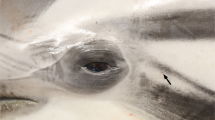Summary
Two types of electroreceptors, the ampullary and the tuberous electroreceptor (silurid knollenorgan) in the epidermis of the catfish, Pseudocetopsis spec., were investigated with semithin and ultrathin serial sections. The ampullary organ contains one or two sensory cells which are embedded in supporting cells at the base of open epithelial canals. They bear some slender microvilli on their apical surface and form several synaptic bars. The afferent myelinated nerve fiber arborizes in the connective tissue papilla and looses its myelin sheath about 30 μm below the supporting cell layer. A second thin myelinated axon occur up to the supporting cell layer. The tuberous electroreceptor organ contains one large receptor cell. Most of the cell body is exposed to the lumen of a specialized proximal canal segment and is closely covered with microvilli. A single myelinated axon looses its myelin sheath within the supporting cell layer about 1 μm before terminating as a flat calyx at the base of the sensory cell. A functional significance of the two types of receptors will be discussed.
Similar content being viewed by others
References
Anderson TF (1951) Techniques for the preservation of three dimensional structure in preparing specimens for the electron microscope. Trans NY Acad Sci 13:130–134
Andres KH, Düring M von (1974) Interferenzphänomene am osmierten Präparat für die systematische elektronenmikroskopische Untersuchung. Mikroskopie 3:139–149
Andres KH, Düring M von (1977) Interference phenomen on osmium tetroxide-fixed specimens for systematic electron microscopy. In: Hayat A (ed) Principles and techniques of electron mciroscopy. Biol Appl. 8 Van Nostrand Reinhold Company, New York, pp 246–261
Bullock TH (1982) Electroreception. Ann Rev Neurosci 5:121–170
Bullock TH, Bodznick DA, Northcutt RG (1983) The phylogenetic distribution of electroreception: evidence for convergent evolution of a primitive vertebrate sense modality. Brain Res Rev 6:25–46
Denizot JP, Derbin C (1969) Sur la régénération des organes récepteur spécifiques cutanées du la ligne latérale du poisson électrique Gymnotus carapo. Arch Anat Microsc 58:249–256
Derbin C, Szabo T (1968) Ultrastructure of an electroreceptor (knollenorgan) in the Mormyrid fish Gnathonemus petersii. J Ultrastruct Res 22:469–484
Derbin C, Denizot J-P (1971) Ultrastructure de l' organe ampullair de Gymnotus carapo (Gymnotidae); origine et nature des mocupolysaccharides. Z Zellforsch 113:531–443
Derbin C (1974) Ultrastructure of the ampullary receptor organs in a Mormyrid fish, Gnathonemus petersii. J Ultrastruct Res 46:254–267
Düring M von, Andres KH (1976) The ultrastrure of taste and touch receptors of the frogs taste organ. Cell Tissue Res 165:185–198
Friedrich YL, Mugnaini E (1981) Preparation of neural tissue for electron microscopy. In: Heimer L, Roberts MJ (eds) Neuroanatomical tract-tracing methods. Plenum Press, New York London, pp 345–374
Fritzsch B, Wahnschaffe U (1983) The electroreceptive ampullary organs of urodeles. Cell Tissue Res 229:483–503
Flock A (1965) Electronmicroscopic and electrophysiological studies on the lateral line canal organ. Acta Otolaryngol [Suppl] 199:1–90
Gaisec RR (1960) Efferent component of the vestibular nerve. In: Rasmussen GL, Windle WF (eds) Neural mechanisms of the auditory and vestibular systems. Springfield, Thomas, pp 176–284
Géry J (1980) Salmler, Zitter und Messeraale. In: Grzimek B (ed) Grzimeks Tierleben Fische 1 Deutscher Taschenbuch Verlag GmbH & Co. KG, München, pp 315–316
Holmes WN, Donaldson EM (1969) The body compartments and the distribution of electrolytes. In: Hoar WS, Randall DJ (eds) Fish physiologoy. Academic Press, New York, pp 1–291
Hopkins CD (1986) Behaviour of Mormyridae. In: Bullock TH, Heiligenberg W (eds) Electroreception. New York. John Willey & Sons, pp 527–576
Jörgensen JM, Bullock T (1987) Organization of the ampullary organs of the African knife fish Xenomystus nigri (Teleostei: Notopteridae). J Neurocytol 16:311–315
Lane EB and Whitear M (1977) On the occurrence of Merkel cells in the epidermis of teleost fishes. Cell Tissue Res 182:235–246
Lissmann HW (1958) On the function and evolution of electric organis in fish. J Exp Biol 35:156–191
Mullinger AM (1964) The fine structure of the ampullary cleetric receptors in Amiurus. Proc Rov Soc B 160:345–359
Peters RC, Wijland F van (1974) Electro-orientation in the passive electric catfish, Ictalurus nebulosus LeS. J Comp Physiol 92:273–280
Reynolds ES (1963) The use of lead citrate of high pH as an electron-opac stain in electron microscopy. J Cell Biol 17:208–212
Roth A (1969) Elektrische Sinnesorgane beim Zwergwels Ictalurus nebulosus (Amiurus nebulosus). Z Vergl Physiologie 65:368–388
Sato M, Katagiri N (1969) Preliminary report of the fine structure of the receptor cells of the small pit-organ of the catfish Parasilurus asotus. Jap J Ichthyol 16:115–345
Srivastava CBL and Seal M (1980) Electroreceptors in indian catfish teleosts. Adv Physiol Sci 31:1–11
Szamier RB and Wachtel AW (1969) Special cutaneous receptor organs of fish: The ampullary organs of Eigenmannia. J Morphol 128:261–290
Szamier RB, Wachtel AW (1970) Special cutaneous receptor organs of fish: Ampullary and tuberous organs of Hypopomus. J Ultrastruct Res 30:450–471
Szamier RB, Bennett MVL (1974) Special cutaneous receptor organs of fish. Ampullary organs of Mormyrids. J Morphol 143:365–384
Szabo T (1974) Anatomy of the specialized lateral line organs of electroreception. In: A. Fessard (ed) Handbook of sensory physiology, vol III/3. Springer-Verlag, Berlin Heidelberg, pp 13–58
Wachtel AW, Szamier RB (1964) Special cutaneous receptor organs of fish: the tuberous organs of Eigenmannia. J Morphol 191:51–80
Wachtel AW, Szamier RB (1969) Special cutaneous receptor organs of fish: Ampullary organs of the nonelectric catfish, Kryptopterus. J Morphol 128:291–308
Waxman SG, Anderson MJ (1986) Regeneration of central nervous system structures. Apteronotus spinal cord as a model system. In: Bullock TH, Heiligenberg W (eds) Electroreception, New York, John Wiley & Sons, pp 183–208
Zakon H (1986) The electroreceptive periphery. In: Bullock TH, Heiligenberg W (eds) Electroreception, New York. John Wiley & Sons, pp 103–156
Author information
Authors and Affiliations
Rights and permissions
About this article
Cite this article
Andres, K.H., von Düring, M. & Petrasch, E. The fine structure of ampullary and tuberous electroreceptors in the South American blind catfish Pseudocetopsis spec . Anat Embryol 177, 523–535 (1988). https://doi.org/10.1007/BF00305139
Accepted:
Issue Date:
DOI: https://doi.org/10.1007/BF00305139




